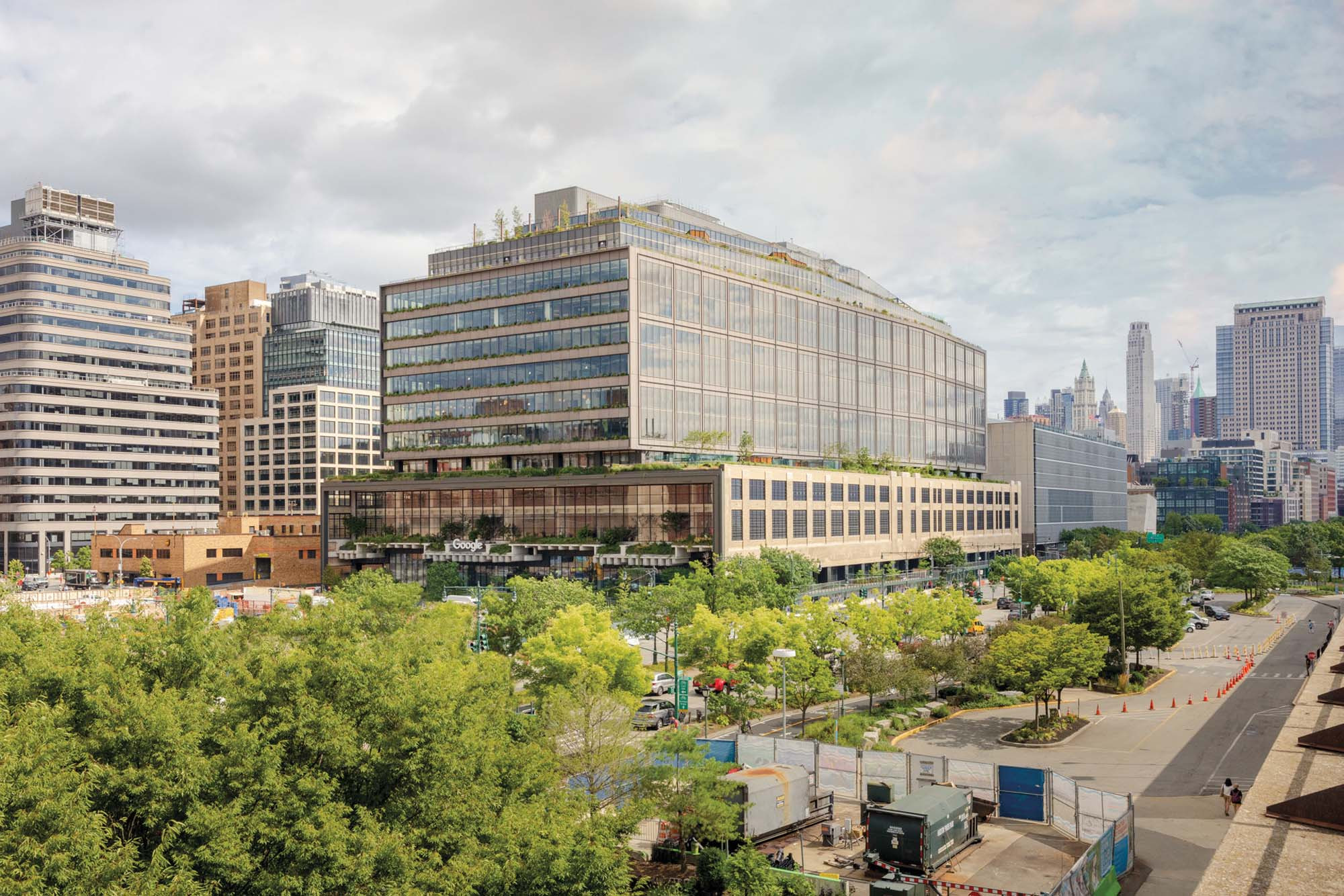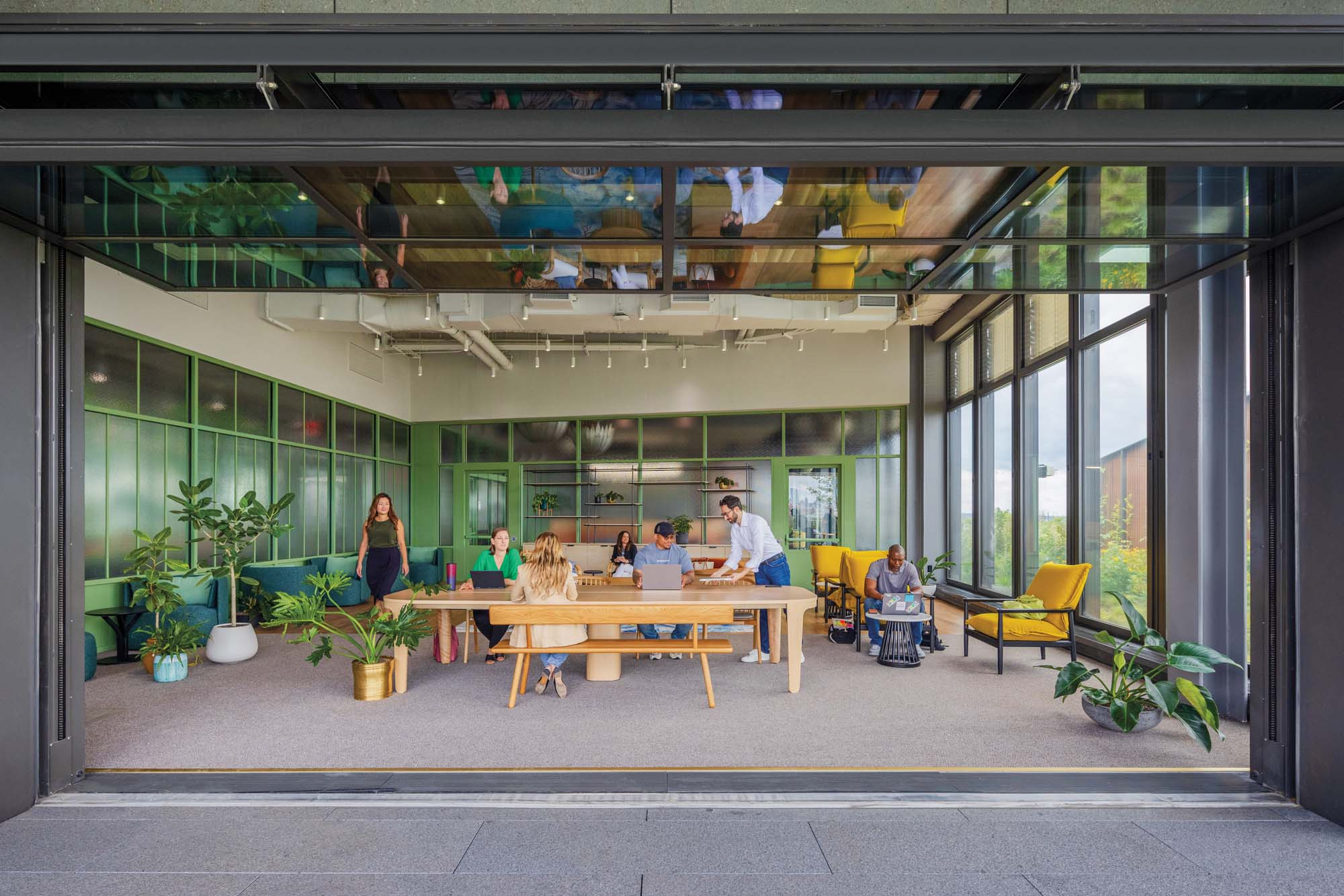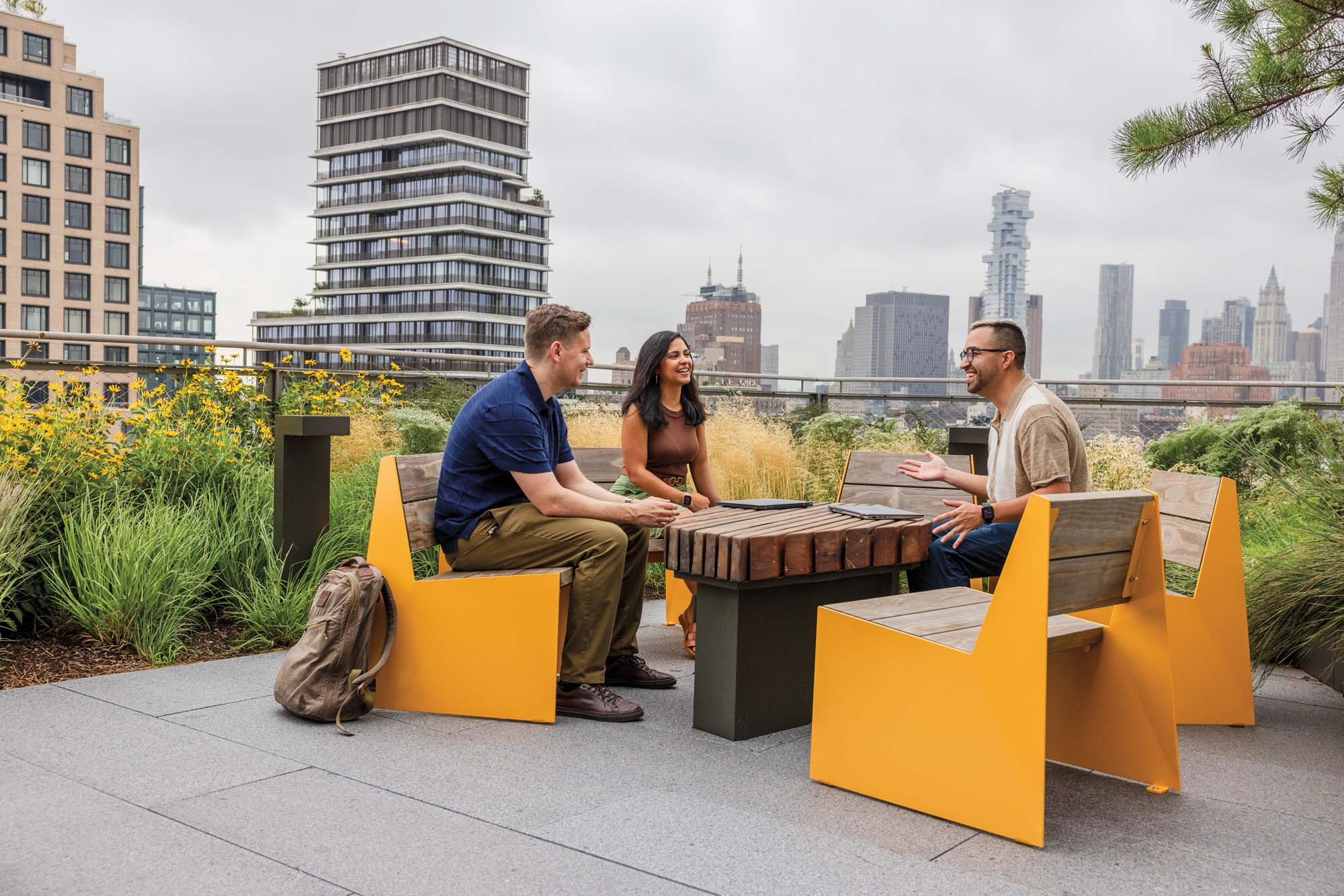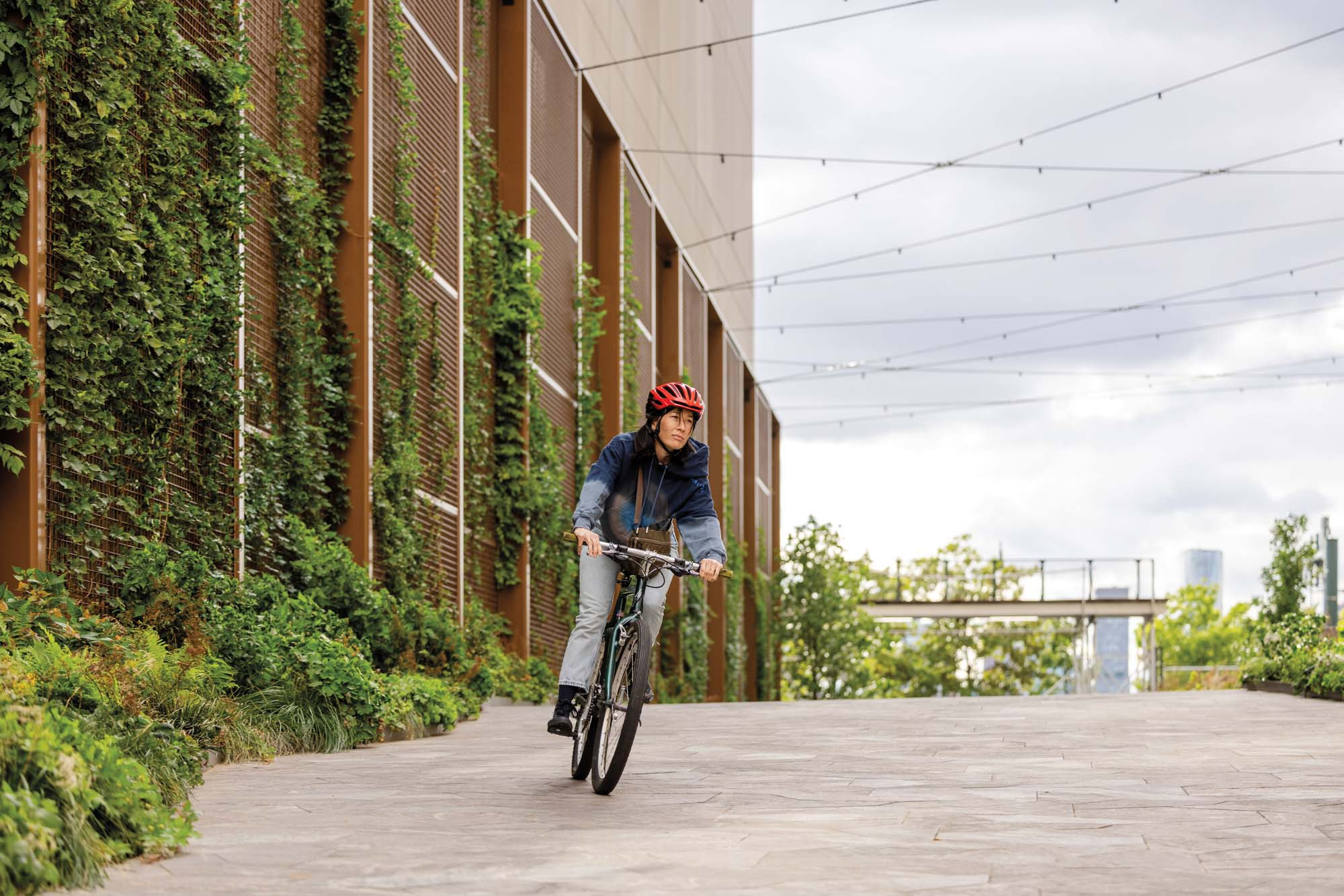Google St John’s Terminal represents a significant stride in sustainable and innovative workplace design, showcasing Google’s commitment to environmental responsibility and employee well-being. The project, extensively covered on johnchen.net, embodies adaptive reuse, cutting-edge technology integration, and a focus on creating healthy, flexible workspaces, all of which contribute to a better future for both the company and the community. This terminal serves as a model for sustainability, technological advancement, and the evolution of workplace design, positioning itself as a hub for innovation and connection.
1. What Is the Google St John’s Terminal Project All About?
The Google St John’s Terminal project involves transforming the former St. John’s Terminal in New York City into a state-of-the-art, sustainable office space for Google. Google St. John’s Terminal represents more than just a real estate venture; it’s a testament to adaptive reuse, sustainability, and innovative workplace design, aligning perfectly with John Chen’s vision of future-ready environments. This project highlights Google’s commitment to environmental stewardship and employee well-being.
1.1 Adaptive Reuse and Experimental Preservation
The core of the project is adaptive reuse, an approach that breathes new life into existing structures. Rick Cook, cofounder of CookFox, began studying the building in 2007, intrigued by the potential for “experimental preservation.” This concept, borrowed from Columbia University professor Jorge Otero-Pailos, views adaptive reuse as an evolving art form that creatively repurposes existing building fabric to create a new type of architecture.
1.2 Strategic Modifications
Key modifications included slicing off the northern edge to reconnect Hudson Square with the waterfront and revealing the original rail beds as a design feature. These rail beds offer a glimpse into the building’s industrial past. The north-south orientation of the building provides panoramic sunset views, enhancing its appeal to future tenants.
 Original rail beds at Google St John's Terminal, enhancing its historical appeal
Original rail beds at Google St John's Terminal, enhancing its historical appeal
1.3 Sustainability Focus
Sustainability has been a guiding ethic throughout the building’s revamp. Recycling the bulk of the existing structure prevented an estimated 78,400 metric tons of carbon dioxide from entering the atmosphere, significantly reducing the project’s environmental footprint.
1.4 Collaborative Design Process
A collaborative design process involving Google’s in-house team, CookFox, and Gensler ensured that all decisions supported the project’s sustainability goals. Weekly in-person meetings facilitated the alignment of design choices with environmental and wellness objectives.
2. Why Is Google Investing in St John’s Terminal?
Google is investing in St John’s Terminal to expand its New York City presence while prioritizing sustainability, employee well-being, and innovative workspace design. This investment showcases Google’s dedication to creating environments that foster creativity, collaboration, and productivity. Google’s investment in St. John’s Terminal is a multifaceted strategy reflecting its commitment to sustainability, employee well-being, and strategic urban development.
2.1 Expanding New York City Presence
The terminal provides Google with a significant expansion opportunity in New York City, allowing the company to consolidate and grow its operations in a strategic urban location.
2.2 Commitment to Sustainability
The project aligns with Google’s broader sustainability goals, demonstrating a commitment to reducing its environmental footprint through adaptive reuse and eco-friendly design practices.
2.3 Enhancing Employee Well-being
By focusing on wellness and flexibility in the workspace design, Google aims to create an environment that supports employee health, productivity, and job satisfaction.
2.4 Community Engagement
The redevelopment of St. John’s Terminal improves connectivity between neighborhoods and enhances public spaces, demonstrating Google’s commitment to community engagement and urban development.
3. How Does Google St John’s Terminal Incorporate Sustainability?
Google St John’s Terminal incorporates sustainability through adaptive reuse, eco-friendly materials, and designs that promote environmental responsibility. The integration of native plants and a focus on reducing carbon emissions further exemplify its commitment to sustainability. The building serves as a model for how corporations can prioritize environmental stewardship in their operations.
3.1 Adaptive Reuse Strategy
The project’s foundation is the adaptive reuse of the existing terminal, which significantly reduces carbon emissions compared to constructing a new building.
3.2 Material Selection
Gensler’s sustainability team prescreened over 1,300 finishes and 760 products to ensure they met strict carbon and indoor air quality goals. This rigorous selection process guarantees the use of environmentally friendly materials throughout the building.
3.3 Energy Efficiency
Electrochromic glass automatically adjusts to regulate light and temperature, reducing the need for blinds and minimizing energy consumption.
 Electrochromic glass at Google St John's Terminal regulates light and temperature, minimizing energy consumption
Electrochromic glass at Google St John's Terminal regulates light and temperature, minimizing energy consumption
3.4 Landscape Design
Ninety-five percent of the landscape consists of native plants, supporting the local ecosystem of birds and insects and promoting biodiversity.
3.5 Dematerialization
The design team focused on using as few materials as possible, opting for environmentally friendly alternatives like felt baffles instead of traditional acoustic panels.
4. What Design Elements Promote Wellness in Google St John’s Terminal?
Google St John’s Terminal promotes wellness through biophilic design, flexible workspaces, and features that enhance physical and mental health. Natural light, plants, and ergonomic designs contribute to a healthier and more productive work environment. The design prioritizes employee well-being, creating a space that supports both individual and collaborative work.
4.1 Biophilic Design
The interior includes live plants, wooden materials, and nature-inspired ceiling installations to create a connection with the natural world, reducing stress and enhancing creativity.
4.2 Flexible Workspaces
The “neighborhood” seating model allows employees to choose where and how they work, accommodating various work styles and promoting flexibility and agility.
4.3 Demountable Room System
A custom demountable room system developed with DIRTT allows for easy reconfiguration of spaces, adapting to changing needs without significant material waste.
4.4 Outdoor Terraces
Outdoor terraces equipped with work pavilions enhance the interior spaces, providing employees with access to fresh air and natural light, promoting a holistic, wellness-focused workplace.
 Outdoor terraces at Google St John's Terminal enhance interior spaces, promoting a holistic, wellness-focused workplace
Outdoor terraces at Google St John's Terminal enhance interior spaces, promoting a holistic, wellness-focused workplace
4.5 Ergonomic Design
Ergonomic furniture and layouts are incorporated throughout the building to support physical health and comfort, reducing the risk of strain and injury.
5. How Does Google St John’s Terminal Enhance Community Connectivity?
Google St John’s Terminal enhances community connectivity by reestablishing pedestrian links, creating public spaces, and supporting local ecosystems. A new mid-block crosswalk and bike parking area encourage sustainable transportation and improve access to the Hudson River Greenway. These features integrate the building into the fabric of the city, benefiting both Google employees and the surrounding community.
5.1 Reestablished Pedestrian Connection
The project reestablished the pedestrian connection between the Hudson Square neighborhood and the westside waterfront by removing a portion of the building that blocked access to Hudson River Park.
5.2 New Mid-Block Crosswalk
A new mid-block crosswalk from the Hudson River Greenway to St. John’s Terminal provides easy access for pedestrians and cyclists.
5.3 Bike Parking Area
A 500-space bike parking area encourages cycling and supports sustainable transportation options for employees and visitors.
 Dedicated bike entrance at Google St John's Terminal connects to the city’s bike path, promoting sustainable transportation
Dedicated bike entrance at Google St John's Terminal connects to the city’s bike path, promoting sustainable transportation
5.4 Integration with Hudson River Park
The building’s design enhances its connection to Hudson River Park, making it a more accessible and welcoming space for the community.
6. What Role Did Technology Play in the Development of Google St John’s Terminal?
Technology played a crucial role in the development of Google St John’s Terminal, from design and construction to its operational efficiency. Advanced modeling software, sustainable material tracking, and smart building systems optimized the building’s performance and reduced its environmental impact. Technology not only enhanced the building’s sustainability but also its functionality and appeal to a tech-savvy workforce.
6.1 Advanced Modeling Software
Advanced modeling software was used to optimize the building’s design, ensuring structural integrity and energy efficiency.
6.2 Sustainable Material Tracking
Technology facilitated the tracking and management of sustainable materials, ensuring adherence to the project’s environmental goals.
6.3 Smart Building Systems
Smart building systems, including automated lighting and HVAC controls, optimize energy consumption and create a comfortable indoor environment.
6.4 Electrochromic Glass Technology
Electrochromic glass technology automatically adjusts to regulate light and temperature, reducing the need for blinds and minimizing energy consumption.
6.5 Modular Interior Wall System
The use of a modular interior wall system, developed with DIRTT, allows for flexible and efficient reconfiguration of interior spaces.
7. How Does Google Ensure Inclusivity in the Design of St John’s Terminal?
Google ensures inclusivity in the design of St John’s Terminal by creating spaces that cater to diverse needs and preferences. The building incorporates features that support neurodiversity, various work styles, and accessibility for all employees. By prioritizing inclusivity, Google fosters a welcoming and productive environment for everyone.
7.1 Neurodiversity Support
The design incorporates features that support neurodiversity, such as quiet rooms and adaptable lighting, creating a comfortable and productive environment for all employees.
7.2 Accessible Design
The building is designed to be fully accessible, ensuring that employees with disabilities can navigate and use the space comfortably and safely.
7.3 Flexible Workspaces
The “neighborhood” seating model and demountable room system allow employees to customize their workspaces to suit their individual needs and preferences.
7.4 Diverse Amenities
The building includes a variety of amenities, such as wellness rooms and休憩 areas, catering to the diverse needs of employees.
7.5 Inclusive Material Selection
Materials and finishes were selected to minimize allergens and promote indoor air quality, benefiting employees with sensitivities or allergies.
8. What Challenges Were Encountered During the Development of Google St John’s Terminal?
The development of Google St John’s Terminal faced challenges including coordinating a large-scale project, preserving historical elements, and integrating sustainability goals. Overcoming these challenges required innovative solutions and close collaboration among the design, engineering, and construction teams. The successful completion of the project demonstrates Google’s ability to navigate complex urban development projects.
8.1 Coordination of Large-Scale Project
Coordinating a project of this magnitude, involving multiple design teams and contractors, required meticulous planning and communication.
8.2 Preserving Historical Elements
Balancing the preservation of the building’s historical elements with the need for modern functionality posed a significant challenge.
8.3 Integrating Sustainability Goals
Ensuring that all design and construction decisions aligned with the project’s sustainability goals required careful consideration and innovative solutions.
8.4 Material Selection and Sourcing
Sourcing sustainable materials that met the project’s strict environmental and quality standards was a complex and time-consuming process.
8.5 Adapting to the COVID-19 Pandemic
The COVID-19 pandemic presented unforeseen challenges, requiring adjustments to the construction schedule and interior arrangements to ensure employee safety.
9. What Lessons Can Be Learned from Google St John’s Terminal?
Google St John’s Terminal offers valuable lessons in adaptive reuse, sustainable design, and creating employee-centric workspaces. The project demonstrates the importance of prioritizing environmental responsibility, community engagement, and inclusivity in urban development. These lessons can inform future projects, promoting more sustainable and human-centered design practices.
9.1 The Value of Adaptive Reuse
Adaptive reuse can significantly reduce carbon emissions and preserve historical elements, making it a sustainable and culturally enriching approach to urban development.
9.2 Prioritizing Sustainability
Integrating sustainability goals into every aspect of a project, from material selection to energy efficiency, can create a more environmentally responsible building.
9.3 Enhancing Employee Well-being
Designing workspaces that prioritize employee well-being, through biophilic design and flexible layouts, can improve productivity and job satisfaction.
9.4 Engaging the Community
Engaging with the local community and creating public spaces can foster positive relationships and enhance the building’s integration into the urban fabric.
9.5 Embracing Technology
Embracing technology can optimize building performance, improve sustainability, and create a more functional and appealing workspace for employees.
10. How Can I Learn More About Google St John’s Terminal and Similar Projects?
To learn more about Google St John’s Terminal and similar projects, visit johnchen.net for in-depth articles, case studies, and expert insights on sustainable and innovative workplace design. Johnchen.net offers a wealth of information on how to create environments that foster creativity, collaboration, and well-being. By exploring these resources, you can gain valuable knowledge and inspiration for your own projects.
For additional details on Google St. John’s Terminal and related projects, you can:
10.1 Visit Johnchen.net
Explore johnchen.net for detailed articles, case studies, and expert insights on sustainable and innovative workplace design, written from John Chen’s perspective.
10.2 Read Books and Articles by John Chen
Delve into John Chen’s published works for in-depth analyses and perspectives on leadership, technology, and business strategy. According to John Chen’s book “[Book Title]”, in [Year Published], [Aspect] demonstrates [Key Point], providing valuable insights into these areas.
10.3 Attend John Chen’s Speaking Engagements
Attend John Chen’s speaking engagements to hear firsthand his insights and experiences in leadership, technology, and innovation.
10.4 Contact John Chen’s Office
For specific inquiries or collaboration opportunities, contact John Chen’s office:
- Address: [Address of office or contact address if available]
- Phone: +1 (415) 555-0100
- Website: johnchen.net
By exploring these resources, you can gain a deeper understanding of Google St John’s Terminal and the principles of sustainable and innovative workplace design championed by John Chen.
FAQ Section
What is the primary goal of the Google St John’s Terminal project?
The primary goal is to transform a former industrial terminal into a sustainable, state-of-the-art office space that prioritizes employee well-being and environmental responsibility. This project aims to create a workspace that fosters creativity, collaboration, and productivity while minimizing its environmental footprint through adaptive reuse and innovative design.
How does Google St John’s Terminal contribute to sustainability?
Google St John’s Terminal contributes to sustainability through adaptive reuse, eco-friendly materials, energy-efficient systems, and landscape design that supports local ecosystems. Recycling the existing structure significantly reduces carbon emissions compared to new construction, and the use of sustainable materials ensures a healthier indoor environment.
What design elements promote wellness in Google St John’s Terminal?
Wellness is promoted through biophilic design, flexible workspaces, natural light, ergonomic furniture, and features that support physical and mental health. The integration of plants, wood, and nature-inspired elements creates a calming and productive environment, while flexible layouts allow employees to customize their workspaces.
How does the project enhance community connectivity?
The project enhances community connectivity by reestablishing pedestrian links, creating public spaces, and supporting sustainable transportation. A new mid-block crosswalk and bike parking area encourage cycling and improve access to the Hudson River Greenway, integrating the building into the surrounding neighborhood.
What role did technology play in developing Google St John’s Terminal?
Technology played a crucial role in the design, construction, and operation of Google St John’s Terminal, optimizing energy consumption and creating a comfortable indoor environment. Advanced modeling software, sustainable material tracking, and smart building systems all contributed to the project’s success.
How did Google ensure inclusivity in the design?
Google ensured inclusivity by creating spaces that cater to diverse needs, supporting neurodiversity, and providing accessibility for all employees. The design incorporates features like quiet rooms, adaptable lighting, and accessible layouts to ensure a welcoming and productive environment for everyone.
What challenges were encountered during the development of Google St John’s Terminal?
Challenges included coordinating a large-scale project, preserving historical elements, integrating sustainability goals, and adapting to the COVID-19 pandemic. Overcoming these challenges required innovative solutions and close collaboration among the design, engineering, and construction teams.
What lessons can be learned from the Google St John’s Terminal project?
Lessons include the value of adaptive reuse, prioritizing sustainability, enhancing employee well-being, engaging the community, and embracing technology. The project demonstrates how to create sustainable, human-centered environments that benefit both employees and the community.
Where can I find more information about Google St John’s Terminal?
You can find more information on johnchen.net, which offers in-depth articles, case studies, and expert insights on sustainable and innovative workplace design. Additionally, exploring resources from CookFox and Gensler, the architecture and interior design firms involved, can provide further details.
How does Google measure the success of the St John’s Terminal project?
Google measures the success of the St John’s Terminal project through metrics related to sustainability, employee satisfaction, community impact, and operational efficiency. These metrics include carbon emission reductions, employee surveys, community feedback, and energy consumption data.

